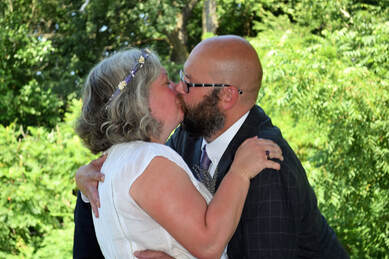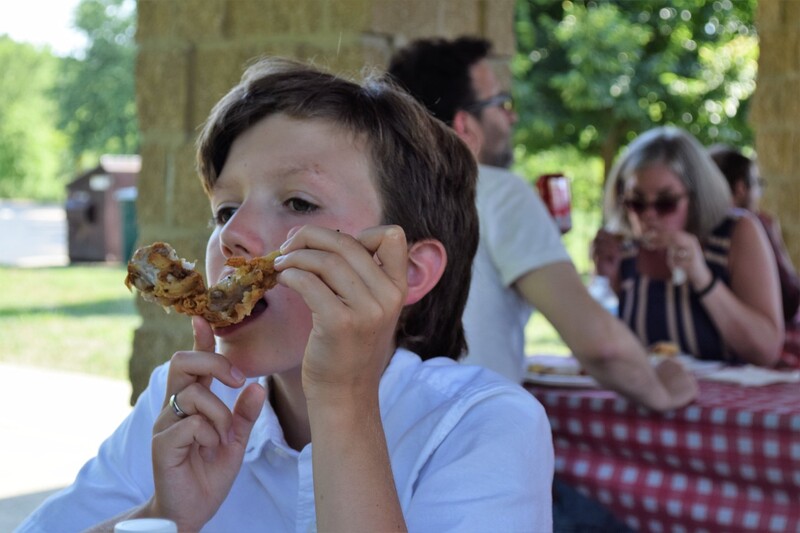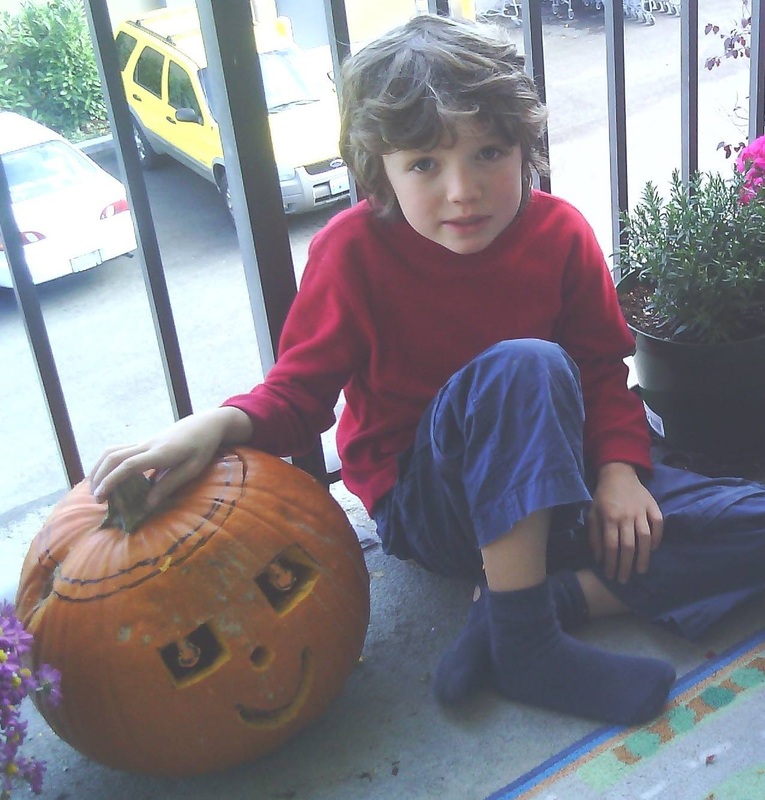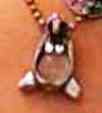|
I was first introduced to Tarot cards over 20 years ago. I had graduated from an Evangelical Christian college and was exploring new-to-me ways of doing spirituality with a spiritual director. One morning, she suggested we work with the Tarot. I was nervous, at first. Was this really an acceptable thing to be doing? Wasn’t this forbidden by our religion? We talked about those thoughts and feelings, and I relaxed into playing with the cards. I was surprised by the perspectives, questions, and insights raised by the process. I began to see the strengths of an eclectic set of spiritual practices. Soon after that experience, I purchased my first deck - the Motherpeace Tarot. I was attracted to the feminist representation of the archetypes, the evocative drawings, and the multicultural intent, which now feels a lot more like cultural appropriation. I’m not comfortable using that deck these days, but a few of the images still resonate with me. The illustration for Death continues to inform and secure my understanding of the card. In Motherpeace, Death is conveyed with a snake shedding its skin. Death is not a final end. It is a process of releasing what was to allow what is next. Shedding a skin is uncomfortable and requires effort. It is also natural and inherent to the life and growth of the snake. Death is a transition to engage and to do actively for the benefit of living and growing. I recently drew the Death card in a reading. I was using the Ethereal Visions deck, which uses Art Nouveau styled imagery to portray the archetype. I had a sense that it was about the end of a chapter versus the closing of a book, but what did that mean for me? It wasn’t until I looked at the same card in multiple decks that the message it conveyed made sense to me. Now, I know what I am shedding and I am working consciously, deliberately, with practice, to let it go. I am hopeful for the new life that is to be released. Is a part of you itching to be shed? Where might something new be emerging in who you are or how you live?
0 Comments
In a joyful ceremony, with friends and family, J and I were married.  We gave special attention to including young N in the ceremony. J made a commitment to N to love and support him as step-father and friend, with care not to replace L. We made promises as a family, in addition to our vows as a couple. N also received a simple silver band as a symbol of the family the three of us make together. Then the party! A picnic reception with plenty of food and cake for all.
Autumn has always been my favorite season. As a child it meant apple picking, apple cider doughnuts, and pumpkins! Pumpkin selecting, pumpkin carving, pumpkin seeds, and pumpkin pie. Every year we made a little trek into "the country" to pick out our pumpkins at a farm stand. We hauled them home to the suburbs for all the ways we enjoyed them. It was looked forward to, even as teens, and served as a sure sign of the season. While there's plenty of country, farms, and farm stands to be found in Washington, Little N and I are urban dwellers these days. And kiddo doesn't take much delight in long drives to unfamiliar places with unfamiliar people, sounds, and smells. So we took the city-dwellers' approach and I picked up a couple of orange beauties at the grocery store next door to our apartment. We invited a friend over and commenced carving. Little N wanted a "happy" pumpkin, so Miss A delighted him by carving exactly what he had drawn for her. I went for a spookier approach, which also allows allows a lot of candle light to shine through, and cut a cyclops from my pumpkin. Kiddo does not like my creepy monster and sequesters it to a different part of our deck, away from his happy creation. From a Pagan perspective this season, like each season, holds sacred meaning. By now we've noticed the days getting shorter, the darkness enfolding us, and in Seattle the cold and rain have started. We inhabit more time indoors. We reach for creature comforts of hot beverages and hardy foods. We are embracing the darkness as best we can and listening for the messages it offers. It's a time for composting that which doesn't serve us, as well as the dreams that have not come to fruition in the time we granted them. New life will be cultivated from their detritus in another season. It's a time for giving thanks for what we have received and that which we have learned. Our lives are stronger and more vibrant for these things. It's a time for drawing near to the folks we love. We are all connected.
Little N doesn't really understand seasons yet. He is puzzled by our dark mornings as I rustle him up for school. He plays out on the deck in dark evenings within the glow of the overhead lights. I don't know if that's due to being a child who hasn't seen as many seasons change as I have, or if it's related to his Autism and not perceiving sequences. I'm hopeful that his comprehension and appreciation will develop as he grows up. To that end, I have the job and the joy of sharing what I perceive in each season. I'm trying to become more intentional in my parenting around this topic and Autumn calls me to it more than any other season. I string little twinkle lights up in our apartment to warm the darkness of our evenings. I make a place on my altar to host the photos of our Beloved Dead, his grandfathers. They have a special place in our hearts and minds at this time of year (more on that and Samhain coming soon). I want Little N to perceive the turning of our little blue planet in our solar system, in our galaxy, in our universe! Our lives are tiny, precious, and changing with our own seasons in this magnificent space. We humans are all connected to each other in various ways and I wonder how to teach him about that as well. I want Little N to experience connection to traditions I grew up with as a link to a family he is part of, a family that loves him, but who he barely knows, rarely sees. I want Little N to be familiar with the emotional and material meanings of entering the dark. We needn't fear or dread the darkness. We can work with and within this season. I want Little N to deeply know all of these things and have fun living with it! So I drag home the pumpkins from the grocery store. We carve them and giggle over the slimy orange goo we pull out of them. We light them and watch the candlelight flicker inside of them. I plug in the twinkle lights. I make room on my altar for the grandfathers. And I try to draw Little N's little-boy-attention to the darkness and what it can offer. On Sunday afternoon my Pagan circle celebrated Mabon, the holiday of the Autumn Equinox. Mabon is the second harvest festival we recognize, this one for later crops like squash and apples. We gathered to give thanks for the light that has sustained us and the bounty of the land, and to prepare ourselves for the coming darkness and cold. Already we observe darker evenings and cooler temperatures. This new season we are entering is referred to as the time of the Dark Mother. She is the Crone aspect of the Triple Goddess. Marked by her sickle and scythe, she comes to reap what has been sown, in the land and in our lives. She has many names in many cultures including: Demeter, Inanna, Kali, Tiamet, Hecate, Nemesis, and Morrighan. The story of Demeter and Persephone is particularly relevant to Mabon. Demeter, the goddess of grain and harvest, loses her lovely daughter Persephone to Hades, the god of the underworld. Either abducted or perhaps descending voluntarily, Persephone is resigned to six months of each year with Hades. Demeter grieves the absence of her daughter and the land is barren. That change, from lush to loss, begins at Mabon. For our ritual, we decorated the altar with garden fresh vegetables and fruit. Bright Mums and Oak leaves stood out in a vase. We crafted candle holders from apples and placed them on the altar to note the four directions and god and goddess at the center. Our meditation focused on seasons of our lives – which season are you entering and how are you preparing for it? We used a Talking Circle to shape the individual sharing and later group discussion around our altar.
I’m entering a season of partner-less among the partnered. Now, more than ever, I feel like our culture places heavy expectations on us to have a partner. The expectation peppers our popular culture in music, television programs, and even commercials. The love-interest. The love unrequited. The love lost. I started dating when I was 13, and while interspersed with solo phases, have usually had a partner or some love interest in my little sphere. Even in those times when there wasn’t a partner, and they were good for me once I adjusted to them, I assumed that there would be again. I’m embarrassed to admit that I’ve drawn some (a lot?) of my sense of worth from being partnered and possessing partner potential. Not so these days. Who wants to date an overweight, 40-year old, divorced mother of a child with special needs? The culture tells me the options aren’t good. So I look ahead and assume a long season of singleness. A season of belonging to myself. I’ve grown to like the idea. I’m choosing how to live in that season and claim it as my own. I think it starts with treating myself as I would a good friend, in my thoughts, words, and actions. I tend my close friendships with time together, authenticity, listening, fun, sharing, patience… and so I will treat myself. It means developing personal practices for my body, mind, and spirit. It includes returning to my dreams for 2014: improved health and weight loss, feeling and expressing my emotions in healthy ways, hosting mini-retreats for women, cultivating a good divorce and co-parenting, and returning to my creativity – especially writing. It stretches to imagine new dreams of confidence, good work, and community. So where I previously experienced loss and confusion, facing this season of living partner-less, I now feel excitement and anticipation. I am a true companion to myself. Composting the distractions, lies, and cultural hubbub, to tend something true, vibrant, and vitally my own. This is my season. *** Note – The Fall Equinox has only recently been named Mabon. It received the name in the 1970s from Aidan Kelley as he wrote Crafting the Art of Magic. He deemed it a useful tool in helping modern Pagans to conceptualize Pagan religious ceremonies. This is interesting to me because it speaks to how contemporary Paganism is both an old religion of ancient myths and symbolism and a young religion that is still being created. I think about that seeming dichotomy a lot as I imagine all the little circles around the country, or around the world, gathering and recognizing the symbols and seasons of the year in their own unique ways, borrowing from the past and infusing it with their own personalities, creativity, and desires. I appreciate the malleability and personalization of this religion because it allows each person to honor Spirit in his or her life in his or her own ways. ready and waiting for my guests they're here! 10 of us gathered and played with 13 decks of Tarot and Oracle cards how auspicious! I drew "Risk" the 40th card of an Oracle deck on my 40th birthday delightful devoured food and drink (1 piece of cake remains for Little N) birthday flowers all around such a lovely little party we all enjoyed!
we sat in a circle in my snug living room and everyone was included stories shared, connections made, new friendships formed I am so happy My little pagan circle celebrated Lughnasadh/Lammas this weekend. It's the first of three harvests that we recognize as pagans. I was high priestess, for the first time!, so it was also a big deal for me and the roles I play in our group. Lughnasadh/Lammas is a crossover holiday originally celebrated by pre-Christian society and later adopted by Christians. Lughnasadh began as a celebration of the god Lugh. He is described as a multi-talented, multi-skilled god, excelling in everything from swordsmanship and blacksmithing, to history, poetry, and harp playing. The holiday was either a recognition of his death day or that of his mother, depending on which accounts you read. It was honored with ritual games, religious ceremonies, matchmaking, legal contracts and more. The holiday also comes at the time of the first harvest, celebrating the abundance of the land and the ongoing survival of the people who depend upon it. Versions of this holiday continue with festivities in parts of Ireland today.
As Lammas, or "loaf-mass", the Christianized holiday focused more on the first fruits of the harvest. People made a loaf of bread from the early crop of grain and brought it to church to be blessed. It's rumored that the loaf was then carried home and used for magic. In our circle, we focused our attention on the harvest aspects of the holiday. We recognized the little crops coming up in our gardens and the seasonal fruit filling our grocery stores as well as the personal growth coming to fruition in our lives and the letting go of what has not bloomed in the time span that we had hoped. For our craft, we made smudge sticks. These small bundles of healing herbs, like rosemary, lavender, and sage, bound together with cotton thread, are used as a tool for cleansing a person or a space for sacred work and connection with the Divine. We also chanted together, raising energy to send to the children at the US border in the form of compassion and courage for the journeys yet ahead of them. We closed the circle with a potluck chat about what we are harvesting in our lives, both the tangibles like fresh zucchini picked that morning and the intangibles like gratitude. For my part, I served as high priestess for this ritual. I don't think of myself as a public, out-in-front leader, but in ritual the role is more subtle and supportive. It's about moving the group through the different pieces as the energy and attention of the people warrants. It's about holding space for folks to have time to complete a given piece and then host the transitions between pieces. So I guided the group from one focus or activity to the next. I also shared the meanings of the holiday, the attention we would be giving to it, and information about the Border Children to whom we were sending our energy and good will. But what about my harvests at this time? I've written a bit in other posts about the dreams I'm working on in this season of my life. This holiday offers a time to reflect on where I'm at in those projects and processes. I haven't lost the weight yet, which I shrilly lament, but I am harvesting better health thanks to the Kind Naturopaths and the Beloved Therapist. I'm still working on a Good Divorce with my ex. In my view, that would look like less cranky conflict and more clear communication and agreements. We're not quite there yet - and maybe we'll never be there but always working on it. As long as we can protect Little N from the conflict and crankiness I'll be able to call it good. I am finding my voice, again, too, a fresh harvest that I hadn't consciously planted but am grateful to find growing up through the cracks. I hear my voice becoming clearer and stronger in many places. In responding to my ex. In my journal. On this blog. Through my un/healthy habits. In our little pagan group. At my job. It requires good work for me to be able hear my own ideas, opinions, feelings, and perspective on a given experience and then give words to it out in the world. It makes a good rich harvest that I'll be tending for the rest of my life. What about you? What are you harvesting these days? In Pagan practice we revere the natural world and the Divine spirit that imbues it. In ritual, our altar bears items for each of the four directions as well as the center. Each direction honors different aspects of nature and human life: the North is for earth and the body; the East is air and the intellect; the South is fire and passion and creativity; the West is water and emotions; the Center is held for Spirit. Setting the altar in this manner is one of the ways that we honor the multi-faceted wholeness of living in this world and living with Spirit. Creating an altar and using ritual items is also a way that we direct our hearts and minds to be present and attentive to Spirit during our time together. These tools aren't necessary all of the time, but we find that practicing with them helps us to get beyond our chattering minds and immediate consciousness to something deeper, something more true, a thread that binds the sacred and mundane together as one in our lives. At Summer Solstice, we recognize the longest day of sunlight, the shifting of the light to shorter days and longer nights, and the first fruits of the harvest. We give thanks for all that the sunlight sustains - including how good it feels on our faces and bodies! In this year's ritual, the first harvest included the gifts that we have received from the Divine to carry into our lives and to share with others. We honored this with readings, songs, and meditation. I selected the image above to meditate with. The image spoke to me about the next phase of my life as a single mother. The skull and the flowers represented the integration of masculine and feminine traits that I embody and balance as Little N's mom. The image also represented independence and endurance. These gifts from the Divine are the strengths that I will call upon as I proceed with the divorce, co-parenting with my ex, and mothering Little N. They are not strengths that I will have; they are strengths that I possess today and am continuing to develop and employ in the coming months and years. They are the strengths that I live with, guide my son with, and share with our friends and community. I've tacked this image up next to my desk as an ongoing reminder, for those days when I feel especially challenged and overwhelmed, of the strengths I have been granted. Following the good work of ritual is the good work of community. We "party like pagans" around a potluck table sharing food, conversation, and warm company. To me, this social time is as important as the spiritual time we inhabit together. This is when we catch up on each other's lives, cultivating our bonds as individual friends and as a cohesive little body. In this social time, we've celebrated births, jobs, and new partners. We've sympathized over losses and brainstormed solutions for each other's challenges. Our lives are enriched and sustained by both the spiritual work and the social work we practice.
As a Christian I'm hesitant to also call myself a Pagan. Frankly, I'm hesitant to apply any labels at all to my spirituality and identity. But this much I claim, in our little group I am met with both good Spirit and good Community. Meaning, this group, too, is one of my gifts from the Divine. |
About Jenni God is the madwoman in the attic.
I'm camped out on the threshold with my journal, camera, & plenty of snacks. God is the madwoman in the attic.
I'm camped out on the threshold with my journal, camera, & plenty of snacks.
Categories
All
Out of the Attic
This blog started in 2006
on Blogger as Out of the Attic. I began posting here in April 2014. Please visit the original site for the rest of the story on topics like: |



























 RSS Feed
RSS Feed




